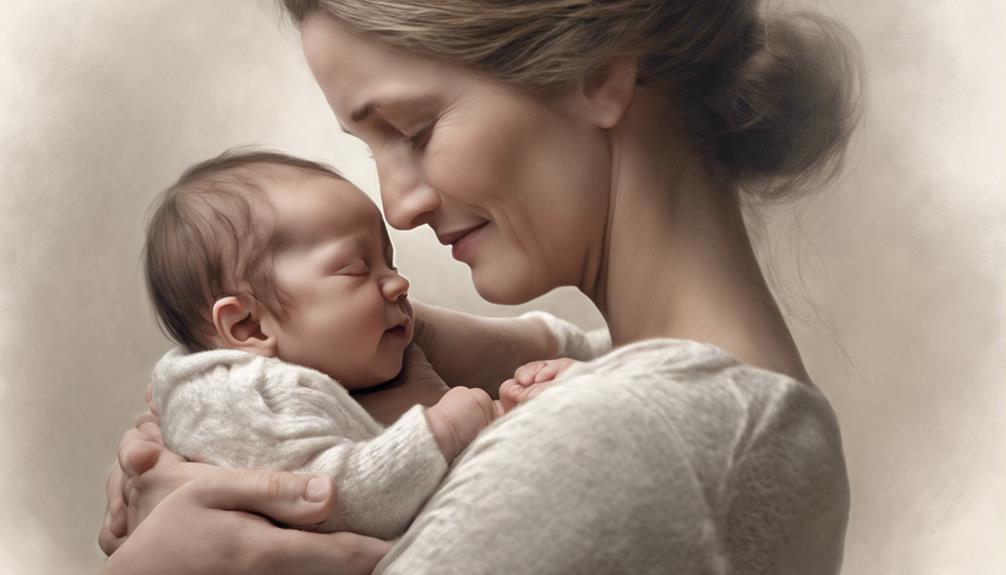Starting the adventure of taking care of a newborn is similar to exploring unfamiliar territories, where every milestone and challenge brings a fresh revelation to be revealed.
The first month with a newborn is a whirlwind of emotions and adjustments, where each day brings new experiences and lessons.
From sleepless nights to the magical moments of bonding, this guide is a beacon of light in the midst of uncertainty, offering insights and strategies to help us navigate this transformative journey with confidence and care.
Key Takeaways
- Feed frequently, look for hunger cues, and monitor diaper output for nourishment and growth.
- Ensure safe sleep practices, monitor sleeping patterns, and establish a consistent sleep routine for newborns.
- Change diapers often, practice proper hygiene, and use diaper cream to prevent rashes and keep baby comfortable.
- Engage in bonding activities like skin-to-skin contact, talking, and interactive play to foster a strong parent-child relationship.
Feeding Your Newborn Baby
During the first month of caring for your newborn baby, feeding them every 1-3 hours is important for their nourishment and growth. Whether you choose breastfeeding or formula feeding, the focus remains on meeting your baby's nutritional needs. Keep an eye out for hunger cues such as mouth movements, rooting, or restlessness, signaling that it's time for a feeding session.
Proper feeding should result in at least 3-4 wet diapers daily, indicating that your little one is well-hydrated and getting enough milk. Additionally, expect around 2-5 bowel movements a day in the initial weeks, prompting regular diaper changes to uphold hygiene and guarantee your baby's comfort.
As caregivers, we recognize the significance of these feeding routines in the early stages of your baby's life. By responding promptly to your baby's hunger signals and monitoring their diaper output, we can confirm they're receiving the nourishment they need to thrive. Remember, each feeding session isn't just about sustenance but also a precious bonding opportunity between you and your newborn.
Sleeping Patterns in Newborns

Observing the sleeping patterns of newborns is essential for ensuring their well-being and development in the important early months of life. Newborns typically sleep for 16-17 hours a day, with intervals of waking every 2-3 hours for feeding and care. Establishing a safe sleep environment is crucial to reduce the risk of SIDS. It's important that babies sleep on their back in a crib without any loose items such as blankets or pillows. By monitoring the baby's sleep patterns and creating a consistent sleep routine, we can enhance their overall sleep quality.
—
| Newborns Sleep | Safe Sleep Environment | SIDS Risk |
|---|---|---|
| Baby's Sleep Patterns | Sleep Routine | Back to Sleep |
| Sleep Quality | Daytime Naps | Monitor Sleep |
| Crib Safety |
—
Diaper Changing Basics
Wondering how to master the art of diaper changing for your newborn? Ensuring proper hygiene and preventing diaper rashes is crucial. Here are some key tips to help you navigate through diaper changes smoothly:
- Change Frequently: Newborns typically need about 10 diaper changes a day to keep them clean and comfortable.
- Wipe Carefully: During each change, remember to wipe gently from front to back to prevent infections.
- Use Diaper Cream: Apply diaper cream as needed to protect your baby's skin from irritation and provide soothing relief.
- Stay Prepared: Keep all your diaper changing supplies handy to streamline the process and make quick and efficient changes.
Soothing Techniques for Newborns

To help your newborn feel calm and secure, consider employing various soothing techniques that mimic the comforting environment of the womb. Swaddling your baby snugly can provide a sense of security, helping them relax and sleep better.
Using white noise machines or playing gentle music can create a calming environment that resembles the sounds they heard in the womb, promoting relaxation. Gentle rocking or rhythmic movements can also be effective in calming fussy newborns and regulating their breathing and heart rate.
Additionally, offering your newborn a warm bath can be a soothing experience, promoting relaxation and potentially improving their sleep patterns. Experimenting with different soothing techniques such as babywearing, gentle massage, or offering a pacifier can help you discover what works best for your baby's comfort and relaxation.
Creating a calm and soothing environment for your newborn is essential for their overall well-being and fostering a sense of security during this early stage of life.
Bonding and Interaction With Baby
When helping a newborn feel calm and secure, it's important to establish a strong bond through interactive and engaging experiences. Here are some key ways to enhance bonding and interaction with your baby:
- Skin-to-Skin Contact: Holding your baby close against your skin not only promotes bonding but also helps regulate their temperature and heart rate.
- Talking and Eye Contact: Communicating with your baby through talking and making eye contact enhances the emotional connection between you both.
- Tummy Time: Engaging in tummy time activities assists in developing your baby's neck, back, and shoulder muscles, promoting physical growth and strength.
- Playing and Interacting: Spending quality time playing and interacting with your baby fosters a strong parent-child bond and creates joyful moments for both of you.
Frequently Asked Questions
What Should I Do With My Newborn in the First Month?
In the first month with your newborn, we prioritize bonding through skin-to-skin contact, strengthening their muscles with daily tummy time, monitoring feeding cues for 8-12 sessions daily, ensuring safe sleep on their back, and tracking hydration with diaper changes.
How Do I Take Care of My Baby in the First Month?
In the first month, we focus on feeding every 1-3 hours for 8-12 times a day, changing diapers about 10 times to keep them comfortable, and ensuring 16-17 hours of sleep. Safety and health are our top priorities.
What Do Babies Start Doing at 1 Month Old?
At 1 month old, babies start focusing on faces and objects, lift their heads during tummy time, bring hands to faces for exploration, and exhibit the sucking reflex. They respond to loud noises, showing growing awareness of their surroundings.
What Are the Essentials for a 1 Month Old Baby?
At one month old, babies need attentive care. Essentials include feeding every few hours, frequent diaper changes, and creating a cozy sleep environment. Providing love, warmth, and gentle interactions supports their healthy development and well-being.
Conclusion
As we navigate the whirlwind of the first month with our newborn, we're reminded of the fragile beauty of new life. Like a delicate flower blooming in the spring, our little one requires gentle care, nourishment, and love to thrive.
Embracing the challenges and joys of parenthood, we're creating a foundation of love and security for our precious baby's journey ahead.
Let's continue to cherish these precious moments and embrace the journey together.









